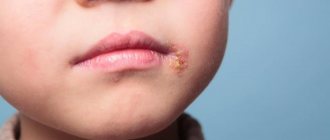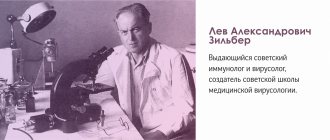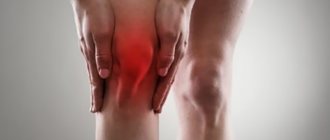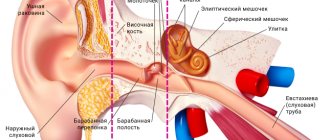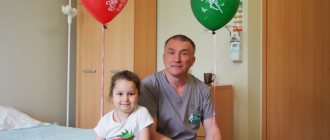Febrile seizures - symptoms and treatment
Febrile seizures are benign conditions in which high body temperature (38°C or higher) changes the electrical activity of neurons in the brain, leading to seizures.
Previously, the term "febrile seizures" was used. However, over time it was replaced by “febrile seizures”, since the concept of “seizures” is much broader and not all seizures manifest themselves as convulsions [1].
Febrile seizures are not associated with infectious lesions of the central nervous system (meningitis, encephalitis, etc.). This is one of the conditions with epileptic seizures that do not require a diagnosis of epilepsy.
Such attacks usually occur in children of infant, early and preschool age: from 6 months of life to 5 years, some sources indicate an age of up to 6 years [9]. In fact, febrile seizures can develop between the ages of 1 month and 8 years. Externally, the clinical picture looks severe: the child loses consciousness, he experiences tonic (in the form of tension) and/or clonic (in the form of twitching) motor phenomena. Despite this, in general this condition has a favorable prognosis.
Convulsions due to febrile fever in children occur quite often: in approximately one child out of 30 under the age of 6 years. And a repeated attack occurs on average in one out of three children [13]. The number of attacks increases in November-January and June-August, this is associated with the highest prevalence of respiratory and gastrointestinal infections, respectively [8].
True febrile seizures should be distinguished from febrile-provoked seizures observed in some forms of epilepsy [14]. In our country, febrile seizures are the responsibility of neurologists, but in most other countries of the world such conditions are included in the range of activities of pediatricians [7].
In the USA and European countries, the average prevalence of febrile seizures among children is currently 2-4% [13][20]. In Russia, no similar epidemiological studies have been conducted in recent years, but there is no reason to believe that the incidence of this pathology in the Russian Federation is in any way different from the average European one.
Causes
Febrile seizures are a multifactorial condition, meaning many factors can contribute to their development. As a rule, their occurrence is characterized by a combination of genetic predisposition and an infectious agent that causes fever [7]. Febrile seizures are associated with a decrease in the seizure threshold and the body's tendency to develop a high temperature in response to infection [22].
A genetic predisposition is implied due to the prevalence of familial cases of febrile seizures. However, the exact type of inheritance has not yet been established [2]. Several genes have been discovered whose mutations can contribute to the development of febrile seizures, but in clinical practice these mutations are not detected due to their favorable prognosis [7].
Genetic predisposition to febrile seizures varies with age. Before reaching 5-6 months, seizures are rare; in 85% of children they occur before four years of age, on average at the age of 17-23 months. When febrile seizures develop in children under 6 months of age, it is important to exclude neuroinfection in order to avoid diagnostic errors.
The cause of febrile attacks is fever - an increase in temperature to 38 ° C or higher. It should be noted that high temperature can be detected only after the end of the attack [3][5].
Fever can be caused by any infectious disease. Up to 30% of cases of seizures in children of the first year of life are observed against the background of infections caused by human herpes virus type 6. In this case, there is a high probability that the virus will enter the bloodstream and spread throughout the body [7].
Quite often, an increase in temperature to febrile levels is not associated with an infectious process. Non-infectious causes include teething, the effects of drugs or toxic substances, diseases of endocrine, psychogenic, reflex or central origin [16].
Prognosis and preventive methods
The disease is treatable, so the prognosis is positive in most cases. The situation can develop according to two scenarios - complete recovery of the patient, or transition of the pathology to epilepsy. The prognosis is made taking into account the risk of recurrence of seizures in the future, the development of epilepsy, neurological and intellectual disorders.
In most cases, attacks do not recur after the age of six. Neurological disorders are determined by the frequency and type of attacks. The prognosis worsens in the case of frequently recurring seizures of an atypical form - mental disorders are observed (developmental delay, mental retardation), the likelihood of transition to epilepsy increases to 15%.
“What to do about febrile seizures” is a question often asked by concerned parents. Our Center’s specialists advise, first of all, not to panic. When the first symptoms appear, you should immediately seek medical help!
Complications of untreated fever
A common mistake parents make when their child has a fever is the immediate use of antipyretics. This eliminates the symptom of the disease without giving the body the opportunity to use immune resources. The result is the development of complications - a sharp spread of infection, accompanied by a deterioration in the baby’s condition.
But high temperature cannot be ignored. Intense heat turns from a method of protection into a damaging factor. The body suddenly loses fluid, and overload of the heart and lungs develops, which is especially dangerous for young children.
What can cause an attack?
Infections that cause fever. The infection can be caused by bacteria, but more often febrile attacks occur with viral diseases (for example, roseola and influenza).
Vaccinations that cause fever. There is a small chance of febrile seizures after vaccination against measles, rubella and mumps, and diphtheria, tetanus and whooping cough. But the risks from incomplete vaccination are higher than the risk from a febrile attack after vaccination.
Heredity. If either parent has had a febrile seizure, the child is more likely to have seizures with fever.
A febrile attack, especially one occurring for the first time in life, is very frightening for parents. In fact, most of these attacks are not dangerous and do not lead to complications or brain damage. A child with simple febrile seizures is only slightly more likely to develop epilepsy than children who have never had a febrile seizure.
Local tonic convulsions
Muscle spasm in response to excessive physical activity or prolonged uncomfortable position is a common phenomenon. Professional athletes know this more than others, but even for ordinary fitness enthusiasts, sudden muscle pain causes many unpleasant emotions.
A cramped muscle is tense and hard to the touch, and the spasm is accompanied by severe pain. In addition to the calf muscles, convulsive spasms affect the muscles of the neck, and sometimes the muscles of the thigh and forearm can be affected. Usually, local tonic convulsions go away on their own within 5-10 minutes, but it’s still better not to endure the pain.
There is a simple scheme of actions that will help return the muscle to its normal state.
What to do? The most basic cause of spasm is a lack of microelements (primarily magnesium), excessive stress on an insufficiently warmed muscle, or prolonged stay in an uncomfortable position (this is what causes muscle spasms during sleep).
Therefore, people involved in physical exercise are recommended to take additional vitamin and mineral complexes, eat dried apricots before training, avoid dehydration, and most importantly, devote enough time and effort to warming up to “warm up” the muscles.
If a spasm does occur, there are techniques for local impact on the muscle. For example, if you have a spasm in the calf muscles, you need to stretch your leg forward as much as possible and strongly pull your foot towards you.
It is important to know
Parents often mistake normal chills associated with fever for febrile seizures. With such chills, the child's arms and legs may shake rhythmically. This is similar to a seizure, but the child is conscious and reacts if spoken to. So that the doctor can better determine whether what happened was a seizure, and if so, what kind, try to clearly record the duration of the seizure, describe it as specifically as possible, and ideally, record what is happening on video (one person helps the child, the other films it on the phone).
How to help a child during an attack?
- Place your baby on his side on a flat surface and make sure he won't fall or hit anything during the cramp (such as crib bars).
- Record the time and tell the doctor when the attack began and how long it lasted.
Attention! Do not try to open the jaw, do not put anything into the child’s mouth during an attack, this can lead to injuries (broken teeth of the child and injured fingers of the person providing assistance). Do not try to restrict the child's movements during seizures, do not restrain him.
The child may be even more afraid of the attack than the parents. Try to calm him down and support him.
If the attack occurs for the first time in life, lasts longer than 5 minutes, the child is unusually sleepy and lethargic before or after the attack, call an ambulance.
In other cases, immediately show the child to the pediatrician. The doctor should examine the child after the attack to make sure there are no signs of a central nervous system infection (meningitis or encephalitis).
When does a child's temperature rise?
The child's body reacts with a feverish state to external stimuli - pathogenic microbes, viruses, purulent inflammation, organ damage. Pyrogens are formed in the blood - substances that increase body temperature.
Fever is the body's way of fighting infection. Excess heat speeds up metabolism and stimulates the formation of germ-fighting antibodies.
Normal temperature in healthy children ranges between +36-37 oC. Exceeding these indicators is divided into 4 degrees:
- 37-38 oC - low-grade fever;
- 38-39 oC - moderate;
- 39-41 oC - high;
- over 41 °C - excessive.
Doctors recommend not to “bring down the fever” below +38 ° C, so as not to interfere with the body’s protective work.
Recommendations for parents if their child has a fever
First aid for a baby begins with measuring the temperature. The armpit is wiped with a clean towel or napkin and the tip of the thermometer is placed in it. The child's shoulder is pressed to the chest. It is better to hold preschoolers on your lap, fixing the thermometer in the desired position. The measurement time is 10 minutes.
It is more convenient for infants to measure their temperature using a multifunctional thermometer; There are two measurement methods available: contact - by immersing the tip of the thermometer in the ear and non-contact - by measuring in the forehead area.
In case of low-grade fever, the child is undressed and wiped with gauze soaked in cool water. Heat above +38 °C is an indicator of complete rest. The patient is put to bed and offered plenty of fluids.
An antipyretic is given in the following situations:
- temperature above +39 °C, headache and muscle pain;
- convulsions;
- the presence of chronic diseases of the nervous system, lungs, heart;
- baby up to 3 months with temperatures above +38 °C.
Having reduced the temperature to normal or low-grade, the child must be taken to a pediatrician as quickly as possible. To determine the causes and proper treatment of diseases, an examination, blood and urine tests, and sometimes an examination by a pediatric endocrinologist, pediatric surgeon, gastroenterologist, or otolaryngologist are required. At a temperature of +40 oC, you should immediately call an ambulance.
How to treat fever in a child who has previously had febrile seizures?
If the child does not have an increase in temperature during illness or after vaccination, it is not recommended to give antipyretic drugs! This does not reduce the risk of an attack.
If the temperature has risen, medications to reduce it make you feel better overall, but do not help with attacks.
The harm from anticonvulsants for the prevention of febrile seizures outweighs the benefits; they are almost never prescribed.
If a child’s febrile convulsions are prolonged, at the beginning of the attack it is recommended to administer a drug from the benzodiazepine group in the form of an enema, a spray in the nose or a gel on the cheek. Unfortunately, none of these forms are registered in Russia. Therefore, if an attack lasts longer than 5 minutes, an emergency doctor may give an injection of such a medicine.
For antipyretic drugs, children can be given ibuprofen at a dose of 10 mg/kg every 8 hours or paracetamol at a dose of 15 mg/kg every 6 hours. Don't give children aspirin!

